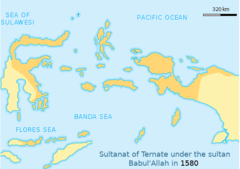Sułtanat Ternate
| 1257–1914 | |
| Język urzędowy | |
|---|---|
| Stolica | Ternate |
| Ustrój polityczny | monarchia |
| Typ państwa | |
| Data powstania | 1257 r. |
| Anektowany przez | Holenderskie Indie Wschodnie |
| Religia dominująca | islam (od 1486) |
 Największy zasięg Sułtanatu Ternate | |
Sułtanat Ternate (indonez. Kesultanan Ternate) – państwo historyczne na terenie dzisiejszej Indonezji, położone w archipelagu Moluków. Powstało w 1257 r. jako Królestwo Gapi[1], przy czym później zmieniło nazwę na Ternate[2]. Należy do najstarszych królestw muzułmańskich w archipelagu indonezyjskim[3]. Państwo Ternate było jednym z czterech tego typu królestw w regionie, obok Tidore, Bacanu(ang.) i Jailolo[4].
Władca Zainal Abidin (1486–1495?) przyjął tytuł sułtana, przekształcając państwo w sułtanat[2][3].
Złoty wiek państwa Ternate przypadł na okres panowania sułtana Babullaha (1570–1583)[1], kiedy to doszło do ekspansji jego terytorium[5]. Państwo objęło terytorialnie większą część wschodniej Indonezji (m.in. północne i południowo-wschodnie Sulawesi, w tym wyspę Buton i region Minahasa, a także część zachodniej Nowej Gwinei) oraz fragment południowych Filipin (wyspa Mindanao)[6]. W okresie od XV do XVII w. Ternate było centrum regionalnej potęgi politycznej oraz głównym producentem goździków[1]. Rywalizowało z Sułtanatem Tidore[7][8]. Odegrało rolę w rozprzestrzenianiu islamu we wschodniej części dzisiejszej Indonezji[8][9]. Współcześnie wyspa należy do Indonezji i nie funkcjonuje jako samodzielny byt polityczny[10][11].
Na terenie państwa posługiwano się językiem ternate oraz malajskim. Mowa rdzennych mieszkańców wyspy jest jednym z dwóch – obok blisko spokrewnionego języka tidore – autochtonicznych języków papuaskich, które wykształciły formę pisaną przed przybyciem Europejczyków[12][13]. Ponadto z Sułtanatu Ternate pochodzą jedne z najstarszych zanotowanych zabytków piśmiennictwa malajskiego, będące także wczesnym przykładem użycia języka malajskiego jako nieojczystego[14].
Pałac (kraton) sułtana Ternate
Wejście do pałacu sułtana
Ruiny fortecy (Fort Kastela) w 2012 r.
Muzyk i grupa tancerek sułtana Ternate
Zobacz też
Przypisy
- ↑ a b c Muzaffar Husain Syed, Syed Saud Akhtar, B. D. Usmani: Concise History of Islam. New Delhi: Vij Books India Pvt Ltd, 2011, s. 332. ISBN 978-93-82573-47-0. OCLC 868069299. (ang.).
- ↑ a b Martijn Theodoor Houtsma, Sir Thomas Walker Arnold, René Basset, Richard Hartmann, Arent Jan Wensinck: The Encyclopaedia of Islām: A Dictionary of the Geography, Ethnography and Biography of the Muhammadan Peoples. T. 4. E. J. Brill Limited, 1934, s. 727. OCLC 39715711. (ang.).
- ↑ a b Kingdom of Gapi / Sultanate of Ternate. History of Culture. [dostęp 2020-06-05]. [zarchiwizowane z tego adresu (2020-06-05)]. (ang.).
- ↑ Studi awal bahasa & kebudayaan Gamkonora: ekologi bahasa di wilayah pesisir dan pedalaman. Jakarta: Lembaga Ilmu Pengetahuan Indonesia, 2010, s. 22. ISBN 978-979-799-583-6. OCLC 714113574. (indonez.).
- ↑ Abd Rahman Hamid: Jejak Arung Palakka di Negeri Buton. Makassar: Pustaka Refleksi, 2008, s. 26. ISBN 978-979-3570-89-1. OCLC 300278612. (indonez.).
- ↑ Leontine E. Visser: Foreign Textiles in Sahu Culture. W: Mattiebelle Gittinger (red.): To Speak with Cloth: Studies in Indonesian Textiles. Los Angeles: Museum of Cultural History, University of California, 1989, s. 81–90. ISBN 978-0-930741-17-4. OCLC 20970370. [dostęp 2020-06-05]. (ang.).
- ↑ John Braithwaite, Valerie Braithwaite, Michael Cookson, Leah Dunn: Anomie and Violence: Non-truth and Reconciliation in Indonesian Peacebuilding. Canberra: ANU E Press, 2010, s. 197. DOI: 10.26530/OAPEN_458801. ISBN 978-1-921666-23-0. OCLC 516510060. [dostęp 2022-10-21]. (ang.).
- ↑ a b Hans Hägerdal. Trajectories of the early-modern kingdoms in eastern Indonesia: Comparative perspectives. „HumaNetten”, s. 66–87, 2016. DOI: 10.15626/hn.20163704. ISSN 1403-2279. [dostęp 2022-10-21]. (ang.).
- ↑ Leonard Andaya: The Spread of Islam. W: World and Its Peoples: Eastern and Southern Asia. T. 10. New York: Marshall Cavendish, 2008, s. 1336–1337. ISBN 978-0-7614-7643-6. OCLC 80020223. [dostęp 2022-09-13]. Cytat: The Moluccan kingdoms of Ternate and Tidore then brought the new faith to their subject islands farther east and to the coasts of Papua. (ang.).
- ↑ Peter Levenda: Tantric Temples: Eros and Magic in Java. Lake Worth, FL: Nicolas-Hays, Inc., 2011, s. 44. ISBN 978-0-89254-169-0. OCLC 719427754. (ang.).
- ↑ Ch. F. van Fraassen: Ternatan/Tidorese. [w:] Encyclopedia of World Cultures [on-line]. Encyclopedia.com. [dostęp 2022-09-23]. (ang.).
- ↑ Holger Warnk, The coming of Islam and Moluccan-Malay culture to New Guinea c.1500–1920, „Indonesia and the Malay World”, 38 (110), 2010, s. 109–134, DOI: 10.1080/13639811003665454, ISSN 1363-9811, OCLC 4839504188 (ang.).
- ↑ Paul Michael Taylor, From mantra to mataráa: Opacity and Transparency in the Language of Tobelo Magic and Medicine (Halmahera Island, Indonesia), „Social Science & Medicine”, 27 (5), 1988, s. 425–436, DOI: 10.1016/0277-9536(88)90365-6, ISSN 0277-9536/88, OCLC 115847538 (ang.).
- ↑ James N. Sneddon: The Indonesian Language: Its History and Role in Modern Society. Sydney, NSW: UNSW Press, 2003, s. 62. ISBN 978-0-86840-598-8. OCLC 54106302. (ang.).
Linki zewnętrzne
- Anton Olegowicz Zacharow, Tiernatie, Bolszaja rossijskaja encykłopiedija [dostęp 2022-10-21] (ros.).
- Rani Rahayu, Iswara N Raditya, Sejarah Kesultanan Ternate: Kerajaan Islam Tertua di Maluku Utara, Tirto.id, 9 lipca 2019 [dostęp 2021-08-05] [zarchiwizowane z adresu 2021-08-05] (indonez.).
Media użyte na tej stronie
(c) Fifteen22 z angielskiej Wikipedii, CC BY-SA 3.0
A section of the ruins of Kastella on Ternate in 2012
(c) Tropenmuseum, part of the National Museum of World Cultures, CC BY-SA 3.0
Female dansers and musician of the Sultan of Ternate
Autor: AtlasMapper, Licencja: CC BY 3.0
Sultanat of Ternate in 1580, under the sultan Babul'Allah.
Based under https://commons.wikimedia.org/wiki/File:Majapahit_Empire.svg Resources used to create the map:
Majapahit, Kompas Daily, Jakarta Indonesia Latif, Chalid; Irwin Lay , ed. (1997) Atlas Sejarah Indonesia dan Dunia (Historical Atlas of Indonesia and World), PT Pembina Peraga, Jakarta (in indonesian) IPS Terpadu (Sosiologi, Geografi, Ekonomi, Sejarah), PT Grafindo Media Pratama, p. 219 ISBN: 9789797583378Wikipédia
(c) Tropenmuseum, part of the National Museum of World Cultures, CC BY-SA 3.0
Negatief. Kraton van de Sultan van Ternate
(c) Tropenmuseum, part of the National Museum of World Cultures, CC BY-SA 3.0
Entrance to the palace of the sultan of Ternate
Autor: Kainjock, Licencja: CC BY-SA 4.0
Keraton (Sultan's palace) in the city of Ternate, Indonesia










